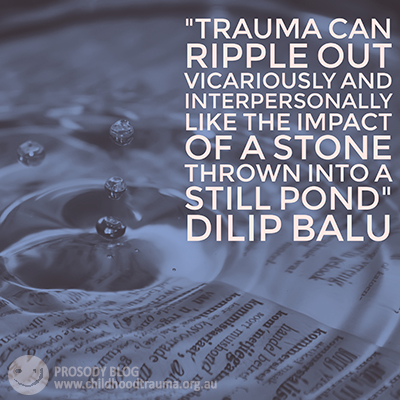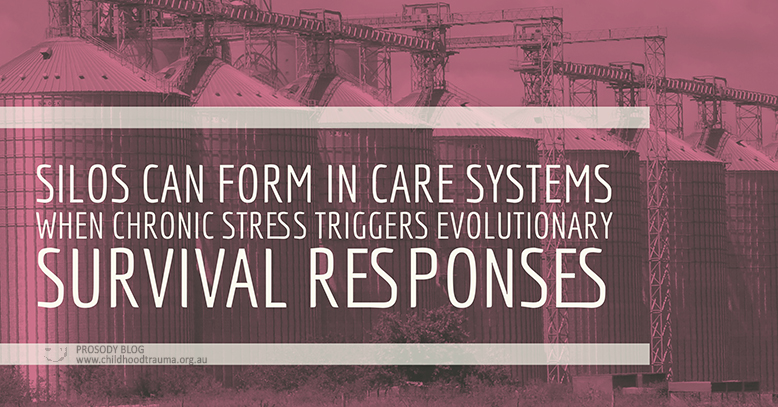
Untying the Knot
This blog article was authored by Dilip Balu, Senior Social Worker and Clinical Senior based at Child Protection Counselling Service (CPCS) within the Integrated Violence Prevention and Response Service (IVPRS) at Nepean Blue Mountains Local Health District.
In my paper presentation at the ACF International Childhood Trauma Conference on 8th June 2016 in Melbourne entitled ‘Untying the Knot: Trauma Informed Care in a Tertiary Adolescent Setting’, I asked the audience the following question:
‘Can a support or treatment system that is fragmented by the demands of dealing with traumatic material and experience consistently provide care that helps individuals to experience an healthy and integrated sense of self?’
Some interesting discussion followed and I’d love you to also consider this question now as you read this. You might be wondering how this particular mouthful of a question came to be. Throughout my clinical career working within mental health care systems, I’ve observed to differing extents a tendency for systems of care to work in isolation of one another. I’ve seen how teams can become inwardly focussed and rejecting of alternative points of view expressed by other teams who work in overlap with them (in terms of geography, population and clinical approach). I’ve scratched my head and torn my hair out at times and have existed both reflectively and non-reflectively within teams who work in this way, and have reflected with clinical supervisors, colleagues and others about my observations.
As I’ve learned more about vicarious or secondary trauma and its impact on individuals and teams, I’ve increasingly come to view treatment systems as complex ecologies made up of individuals, subcultural systems (families, professional disciplines, multidisciplinary teams, wider health systems). I’ve observed that systems under stress tend to operate in survival mode, which makes developing and maintaining warm, connected relationships extremely difficult and can lead to increased risk of dissatisfaction and burnout. Trauma theory as expressed by authors such as Siegel (2009) show us (amongst other things) that:
- Trauma and experiences of insecurity and fear are created in relationships; as is a sense of security
- Our intimate personal selves are formed in relationships and our social ecology
- Trauma impacts profoundly on global development, and in particular on the central nervous system with the brain at its core.
It is normal for all subsystems of a larger whole (starting with our own central nervous systems, and moving out to our relationships) to fragment and disintegrate in response to experiences of traumatic stress (Siegel 2009). Being in survival mode means individuals can become more reactive, short-term survival focussed, and less able to look at the bigger picture under this kind of severe stress. This can be adaptive in the short term and problematic if it continues due to lack of safety and reparation. Individuals develop within, and create  relationships constantly, and relationships make up systems. Trauma can also ripple out vicariously and interpersonally like the impact of a stone thrown into a still pond; fragmenting systems and the relationships that constitute them and creating a cycle of traumatic experience and increased inward focus that is not consistent with reaching out across barriers; rather more consistent with operating in silos (Kulkarni & Bell 2012). As a field, we are starting to understand more and more keenly that it is extremely difficult to heal from traumatic experiences (that teach people to be on the lookout constantly to protect themselves from more pain in the future) without therapeutic support that helps us to work through this pain in the present and relate to people in safer and healthier ways (Higgins, Hunter & Wall 2015). By finding ways to break these cycles in the present, we create the priceless opportunity to break intergenerational cycles of trauma in vulnerable families and communities (in particular our Indigenous Australian First Peoples) (Atkinson, Atkinson & Nelson 2010).
relationships constantly, and relationships make up systems. Trauma can also ripple out vicariously and interpersonally like the impact of a stone thrown into a still pond; fragmenting systems and the relationships that constitute them and creating a cycle of traumatic experience and increased inward focus that is not consistent with reaching out across barriers; rather more consistent with operating in silos (Kulkarni & Bell 2012). As a field, we are starting to understand more and more keenly that it is extremely difficult to heal from traumatic experiences (that teach people to be on the lookout constantly to protect themselves from more pain in the future) without therapeutic support that helps us to work through this pain in the present and relate to people in safer and healthier ways (Higgins, Hunter & Wall 2015). By finding ways to break these cycles in the present, we create the priceless opportunity to break intergenerational cycles of trauma in vulnerable families and communities (in particular our Indigenous Australian First Peoples) (Atkinson, Atkinson & Nelson 2010).
It was wonderful to hear Dr Dan Siegel (2012) at the International Childhood Trauma Conference this year helping us all define the mind as being emergent property of the body and relationships that is in part constituted by an “embodied and relational process that regulates the flow of energy and information.” Dr Siegel (2012) beautifully and elegantly emphasizes the interdependence of brain (mechanism), mind (regulation) and relationships (sharing) in his book ‘The Developing Mind’. Trauma can impact on this interdependent, integrated emergent process by breaking the linkages between differentiated parts of this complex process, thereby moving away from harmony and integration to chaos and rigidity (Siegel 2012).
Ask yourself, how might this feel if you’re part of a system of care that works with traumatic experience every day? My personal experience of working within stressed care systems is that of a strong and persistent urge to ‘clock in an clock off’ while focusing on the basic tasks of each day in a structured fashion that tries to build predictability into an unpredictable experience. I have experienced a narrowing of creative capacity, which Russell Meares so beautifully explores as the adult equivalent of play in the lives of children (Meares 2005). A greyer, less full, and less enjoyable existence, however one that is adaptive in reducing the risk of further threat and stress in the short term. One might see this ‘greyer’ existence as fitting somewhere on the dissociative spectrum of neurobiological response to threat and/or chronic stress (Meares 2012).
What if we were to use the brain as a metaphor for a care system? Let’s say neurons are like the individuals within a care system (e.g. a multidisciplinary mental health team) and the part of the brain as like teams within that care system (e.g. limbic system, brain stem, pre-frontal cortex, etc.) What does securely attached play-based relational interaction allow us to do? If we look at Siegel’s (2012) model of the mind we can see that experiential neuronal connections are made in the context of these healthy and safe relationships that link sub-parts. Exploration allows for these connections. These connections form neural pathways and maps, which then become integrative at the level of emotional development and self-regulation (horizontal and vertical) and non-linear in nature (i.e. formed by free creative associative processes). Further exploration into the world of relationships allows for this emergent process to continue unimpeded. In a care system this might take the form of:
- Safe, open and transparent communication and resolution of conflict and difference;
- The blossoming of creativity in service development, clinical care and problem solving, and;
- The integration of the different sub-parts of the system (e.g. professional disciplines, teams, agency partners, etc.).
So then I ask; do care systems also have emergent properties related to connection and integration of differentiated parts? If so, then what happens when chronic stress triggers evolutionary survival responses that disrupt the formation of these harmonious, flexible and non-linear connections and maps between neurons (people)? Maybe different connections/pathways can be formed that are more rigid and linear in nature and less integrative of differentiated parts. Some ways of describing this could be; fragmented, disconnected, dissociated.  In care system terms; the formation and maintenance of silos operating mysteriously in parallel to each other without connections. A bit like traumatic memory pathways that have no direct knowledge of the experiential content of each other (Meares 2012).
In care system terms; the formation and maintenance of silos operating mysteriously in parallel to each other without connections. A bit like traumatic memory pathways that have no direct knowledge of the experiential content of each other (Meares 2012).
How does this then relate to my core question? Well in essence, trauma informed models such as the Sanctuary Model emphasise the beautiful and essential primacy of relationships to the functioning of individuals, and systems these individuals inhabit and interact with (Bloom & Farragher 2011). Systems, both formal (e.g. professional) and informal (e.g. families) share this common factor. However, in my experience, it is much easier to see this kind of process if you are a person who exists outside of a direct system of care who can take an observer perspective. The next best approach may be for those within a stressed care system to invite transparent care delivery and feedback from observers to help inform the understanding within systems of their ways of operating. Collaborative care is a health system term and approach that can encompass this kind of living process. It means working beyond boundaries that impose unnecessary barriers and within necessary limits (both personal and professional). The systems embodiment of secure attachment as indicated by warmth with clear limits and the ability to balance aloneness and togetherness (Siegel 2009;Meares 2005). It takes the ability to overt and discuss ‘wicked’ interpersonal problems that are patterned and fixed in nature (Dunoon 2008). There can be many elephants in many rooms within service system structures.
Either way, it seems clear that it’s everyone’s business and it’s trauma informed care business. There must surely be a central role for compassion and kindness-based interactions in the face of fear; promotion of safety as an overt process with an approach/lens that promotes the development of a shared language of collaborative and integrative care (e.g. Sanctuary model). The embodiment of trauma informed care reaches far beyond specialized language and into lived experience. Courageous, creative and visionary leadership towards process-based change and understanding of existing system cultures is a very valuable commodity. Before all else, there must be an awareness that something is not right (based on one’s own observations of stress levels and dilemmas and how they are shared with colleagues) and a will to lean into these unpleasant and threatening experiences. As Thich Nhat Hanh (2012) so beautifully describes:
Fear keeps us focused on the past or worried about the future. If we can acknowledge our fear, we can realize that right now we are okay. Right now, today, we are still alive, and our bodies are working marvelously. Our eyes can still see the beautiful sky. Our ears can still hear the voices of our loved ones.
References
Atkinson J, Nelson J, Atkinson C. Trauma, transgenerational transfer and effects on community wellbeing. In: Purdie, P Dudgeon, R Walker; Working Together: Aboriginal and Torres Strait Islander Mental Health and Wellbeing Principles and Practice. Canberra ACT; Commonwealth of Australia, 2010; 135-144.
Bloom S.L & Farragher B. (2011) Destroying sanctuary: the crisis in human service delivery systems. Oxford Press New York.
Dunoon D (2008) In the leadership mode: concepts, practices, and tools for a different leadership. Trafford, Victoria, Canada.
Kulkarni, S. & Bell, H (2012) Trauma and the organization: understanding and addressing secondary trauma in a trauma-informed system. Presented at the Moving Forward in Challenging Times Conference July 6-8, 2011, SafePlace Austin, TX Trauma and the Organization. http://safeaustin.org/wp-content/uploads/2013/12/Paper2-Trauma-and-the-Organization.pdf
Meares R.J.(2005) The metaphor of play: the origin and breakdown of personal being. Routledge East Sussex.
Meares R.J (2012) A dissociation model of borderline personality disorder. W.W Norton New York.
Nhat Hanh T (2012) Fear: essential wisdom for getting through the storm. Harper Collins New York.
Siegel D.J. (2009) Mindsight: change your brain and your life. Brunswick VIC Scribe
Siegel D.J. (2012) The developing mind: how relationships and the brain interact to shape who we are, second edition. Guildford Press New York
Wall, L., Higgins, D., & Hunter, C. (2016). Trauma-informed care in child/family welfare services (CFCA Paper No. 37). Melbourne: Child Family Community Australia information exchange, Australian Institute of Family Studies.
https://aifs.gov.au/cfca/publications/trauma-informed-care-child-family-welfare-services
